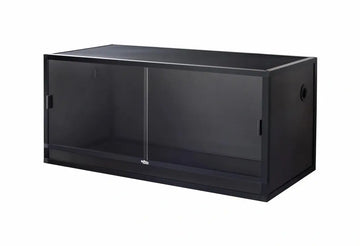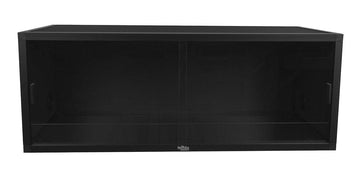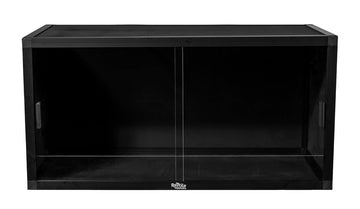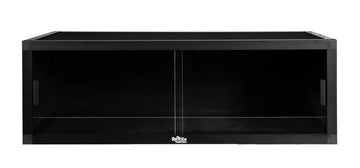Chinese cave geckos (Goniurosaurus sp.) are small, nocturnal, terrestrial lizards native to China, Vietnam, and Japan. Their preferred habitat is rocky outcrops and caves within lowland rainforests.
There are 13 different species of Goniurosaurus, and each one looks slightly different. However, generally speaking, Chinese cave geckos tend to have a gold and brown/black pattern, with a black and white banded tail, red eyes, and bumpy skin. Unlike many other geckos, Chinese cave geckos have eyelids and lack sticky toe pads, although their claws still make them proficient climbers.
Chinese cave geckos are intermediate-level pet reptiles due to their sensitivity to heat and high humidity requirements. With good care, they can be expected to live around 10-12 years.
Chinese cave geckos’ care requirements are generally fairly similar from species to species, however there are essential differences that should be noted. This care sheet should be used only as a general guide, and we strongly recommend doing research on your specific species of cave gecko for best results.
Minimum terrarium size for Chinese cave geckos
The absolute minimum terrarium size for a single Chinese cave gecko is 30”L x 12”W x 12”H, or a 20 gallon long tank. Of course, larger is always better, and highly recommended!
Housing multiple Chinese cave geckos together is possible, as they are known to get along well in groups, but this is not required for their wellbeing. To house a group together, you will need an enclosure at least twice the minimum recommended size, and only females should be housed together, as males will fight.
Do Chinese cave geckos need UVB?
Technically they can survive without it, but we still recommend providing appropriate UVB lighting for Chinese cave geckos. UVB lighting helps provide a clear day/night cycle, provides all of the vitamin D that your pet needs, strengthens the immune system, facilitates better digestion, and other benefits.
The best UVB bulbs for Chinese cave geckos are:
- Zoo Med T8 ReptiSun 5.0
- Arcadia ShadeDweller Kit
For best results, use a bulb 1/3 to 1/2 the length of the enclosure and house it in a reflective Arcadia or Vivarium Electronics fixture. Position the lamp on the same side of the terrarium as the heat lamp, 8-10” above the basking surface. UVB is blocked by glass and plastic, so placing the terrarium in front of a window doesn’t count as “free UVB” — in fact it can make your terrarium too hot due to the greenhouse effect. Don’t forget to replace your bulb every 6-12 months per manufacturer recommendation.
Lights should be on for 13.5 hours/day during summer and 10.5 hours/day during winter as part of seasonal cycling.
Best temperature for Chinese cave geckos
Although they are commonly considered to be “room temperature” reptiles, Chinese cave geckos do benefit from having a low-temperature basking area. After all, they’re still reptiles, and that means they need a range of temperatures in their enclosure that allow them to thermoregulate.
Chinese cave geckos should have a low basking temperature between 80-82°F, as measured by a digital probe thermometer with the probe positioned in the basking area. The cool zone of the enclosure should stay between 72-75°F, and nighttime temps can drop as low as 68°F.
Provide heat for your Chinese cave gecko with a low-wattage incandescent bulb. White heat bulbs are the best way to imitate the warmth of sunlight indoors, and considered to be a superior form of reptile heating by experts. Do not use red or blue bulbs, as these are not as effective.
Best humidity levels for Chinese cave geckos
Chinese cave geckos need high humidity levels of 70-80%, and absolutely no lower than 60%. Humidity should be measured via digital probe hygrometer, with the probe placed in the middle of the terrarium.
Increase humidity by misting the enclosure 2x/day with a spray bottle. Mist in the evening after lights out, then again in the morning. Aside from raising humidity, this also provides an important source of drinking water! If you still need help maintaining humidity, installing a cool mist humidifier to run at night is useful. Finally, your gecko should always have access to a humid cave/burrow.
Best substrate for Chinese cave geckos
Providing a layer of naturalistic substrate (“bedding”) will help maintain correct humidity levels and also helps make your enclosure more attractive! We recommend the following substrates for Chinese cave geckos:
Layering clean, chemical-free leaf litter on top of the substrate can also help with humidity.
Substrate should be at least 3” deep and completely replaced every 3-4 months. Remove poop and urates daily, along with contaminated substrate.
How to decorate a Chinese cave gecko terrarium
An empty terrarium makes for a bored lizard, reducing its quality of life. Keep your pet entertained and engaged with its environment with the strategic use of décor items that encourage it to exercise natural behaviors!
Chinese cave geckos spend most of their time on the ground, but they still do some low climbing, so you will need objects that accommodate this lifestyle and meet their other needs. At bare minimum you need at least two hiding places. Here are some ideas:
- hides
- branches
- cork tubes
- cork flats
- ledges
- more live or artificial plants
- textured background
What to feed to a Chinese cave gecko
Chinese cave geckos are insectivores, which means that they need to get the majority of their nutrition from insects. Juveniles should be fed daily, and adults should be fed 3-5x/week depending on body condition. Feeding sessions should last about 5-10 minutes. Each insect should be slightly smaller than the gecko’s head.
Feeder insects for Chinese cave geckos: dubia roaches, discoid roaches, red runner roaches, crickets, black soldier fly larvae, hornworms, mealworms, mealworm beetles, silkworms
Supplements
You will also need calcium and vitamin supplements to prevent your pet from developing a deficiency. We recommend Repashy Calcium Plus LoD, lightly dusted on all of your lizard’s feeder insects at every other feeding.
Water
Of course, don’t forget a medium-sized, shallow bowl for your lizard to drink from! Change the water daily and scrub the bowl with a reptile-safe disinfectant weekly, or whenever it becomes soiled.
How to handle your Chinese cave gecko
Reptiles generally don’t appreciate petting and handling in the same way that dogs and cats do. Chinese cave geckos generally prefer to be left alone, and attempting to handle them is likely to just stress them out. If you want to bond with your lizard, try hand-feeding it with feeding tweezers instead.
*This care sheet contains only very basic information. Although it’s a good introduction, please further your research with high-quality sources. The more you know, the better you will be able to care for your pet!
"File:Goniurosaurus orientalis mâle.jpg" by Lisen67 is licensed under CC BY-SA 4.0












1 comment
These bad boys are my #1 favorite herptile in the world. Love them to DEATH, and have three individuals of my own. Heres a few super important things I would add.
1)They do better in a group.
Cave geckos absolutely THRIVE when they have a partner. You don’t have to do multiple as they said, but they eat better, are more active, and grow more rapidly. If you have a solo male, it sadly may be hard to find a female for sale, so don’t fret too much. If you do manage to get another, no matter what, no males together, and no related males and females to prevent inbreeding.
2)Don’t go under a 40 gallon.
Cave geckos are massive night roamers. They will use every inch to crawl around and explore/hunt once the sun goes down, and a 20 gallon or under just doesn’t allow them that primal exploration. This is very important to keep them stimulated.
3) They need a bioactive enclosure.
You can’t maintain the humidity and the temperate microclimate in anything that isn’t bioactive. The enviornment needs to stay constant, and the only way it can do such is with a living ecosystem.
4) You need to stock their enclosures.
Lots of clutter, leaf litter, logs, bark, and hides are best for these animals. They will use every nook and cranny, and too barren of a space makes for a very unhealthy/stressed gecko. They will not eat if they feel exposed, and will become malnourished.
5) They should be given a textured background.
Whether you DIY it or buy premade foam or cork one, they require climbing space. They are big climbers in the wild, going up mountain ledges and hillsides, and they will climb any and everywhere they can. It also keeps their claws from getting too sharp by filing them down, and their claws can induce quite the allergic reaction for some people.
6) They are massively picky eaters.
They don’t eat mealworms, grubs, or anything that doesn’t move quickly. It’s very hard to get them to, even if they’re all that is offered. They like crickets best, but roaches are also acceptable. Varied diet is best with them.
7) Calcium is extra important.
Don’t give too much as they may consume an unsafe amount of D3, but don’t skimp on the calcium ever, because it shows quickly. Occasional vitamin A is also good.
Thats about all I’d say on what’s nescessary to know. Some FUN things that most don’t know are that these guys are insanely soft. Almost velvety. If you’re ever having to move them or touch them, you’ll be suprised. Secondly, they bark. It’s faint but if it’s quiet enough you’ll hear a rapid series of barks that can be described as “tokay sounds but witha much lower volume”. They only do so when under immense stress, such as being squeezed or grabbed suddenly (I grabbed a towel she was hiding under after escaping, and only realized when she started barking at me). Lastly, beware, as they are absolutely escape artists, and if given the chance will go off into the night. Make sure your enclosure is 100% escape proof. I hope you can come to love these guys as much as I do, and I hope that yours thrives under your care!